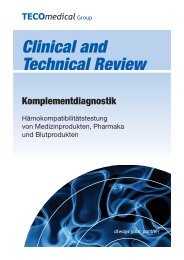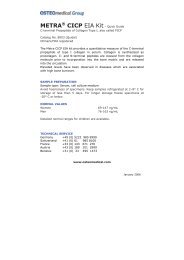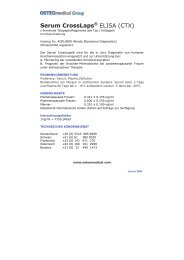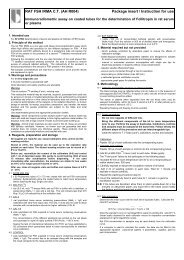Page 1 E N G LIS H D E U T S C H ITA LIA N O F R A N Ç A IS E S P ...
Page 1 E N G LIS H D E U T S C H ITA LIA N O F R A N Ç A IS E S P ...
Page 1 E N G LIS H D E U T S C H ITA LIA N O F R A N Ç A IS E S P ...
Create successful ePaper yourself
Turn your PDF publications into a flip-book with our unique Google optimized e-Paper software.
QUICK GUIDE TO ASSAY STEPS<br />
1. Add 125 µL Assay Buffer.<br />
2. Add 20 µL Standards, Controls, and samples; swirl.<br />
3. Incubate 3 hours ± 10 minutes at 20–28°C.<br />
4. Wash 4 times with 1X Wash Buffer.<br />
5. Add 150 µL 20–28°C Working Substrate Solution.<br />
6. Incubate 30 ± 5 minutes at 20–28°C.<br />
7. Add 100 µL Stop Solution and read optical density at 405 nm.<br />
INTENDED USE<br />
The Metra BAP immunoassay provides a quantitative measure of bone-specific alkaline phosphatase (BAP) activity in serum as an<br />
indicator of osteoblastic activity. Measurement of BAP is intended for use as an aid in the:<br />
� management of postmenopausal osteoporosis and <strong>Page</strong>t’s disease;<br />
� monitoring of postmenopausal women on hormonal or bisphosphonate therapy;<br />
� prediction of skeletal response to hormonal therapy in postmenopausal women.<br />
SUMMARY AND EXPLANATION<br />
The skeletal, or bone-specific, isoform of alkaline phosphatase is a tetrameric glycoprotein found on the cell surface of osteoblasts. 1<br />
Osteoblasts are the cells responsible for synthesis of new bone matrix and its mineralization. The function of BAP has not been fully<br />
elucidated, though its role in skeletal mineralization has been confirmed. 1,2,3<br />
Bone is constantly undergoing a metabolic process called remodeling. 3,4 This includes a degradation process, bone resorption,<br />
mediated by the action of osteoclasts, and a building process, bone formation, mediated by the action of osteoblasts. 3,4 Remodeling<br />
is required for the maintenance and overall health of bone and is tightly coupled; that is, resorption and formation are in balance. 3,4<br />
In abnormal states of bone metabolism this process becomes uncoupled and, when resorption exceeds formation, this results in a<br />
net loss of bone which can lead to osteoporosis, 3,4 or to the disordered bone tissue of pagetic lesions. 5 The measurement of specific<br />
biochemical markers of these remodeling events provides analytical data regarding the rate of bone metabolism or “turnover”. 3,4<br />
Osteoporosis is a metabolic bone disease characterized by abnormal bone remodeling. It is a systemic skeletal disease characterized<br />
by low bone mass and microarchitectural deterioration of bone tissue, with a consequent increase in susceptibility to fractures. 6<br />
The most common type of osteoporosis occurs in postmenopausal women as a result of the estrogen deficiency produced by<br />
the cessation of ovarian function. 3 Restoration of premenopausal estrogen levels by replacement therapy prevents bone loss and<br />
osteoporosis. 3,6 Estrogens and a class of compounds known as bisphosphonates are antiresorptive therapies which can be used to<br />
prevent bone loss or treat osteoporosis. 3,6,7<br />
Osteoporosis can also result from attaining an inadequate peak bone mass during the growing years, an age-related imbalance of<br />
bone remodeling with a net excess of resorption, and a number of clinical conditions and therapies which induce bone loss or bone<br />
remodeling imbalances. 3 These include endocrine diseases such as hypogonadism, hyperthyroidism, hyperparathyroidism, and<br />
hypercortisolism; renal failure; cancers metastatic to bone; gastrointestinal diseases related to nutrition and mineral metabolism;<br />
connective tissue diseases; multiple myeloma; chronic immobilization, alcoholism, or tobacco use; and chronic therapy with heparin<br />
or corticosteroids. 3<br />
<strong>Page</strong>t’s disease of bone is a focal disorder resulting in pain and skeletal deformity in symptomatic patients. 5 <strong>Page</strong>tic lesions are<br />
characterized by bone matrix of highly abnormal structure arising from excessive rates of remodeling activity. The lesions occur<br />
predominantly in the skull, spine, pelvis and long bones, and can result in fractures and neurological impairment. 5 The etiology of<br />
<strong>Page</strong>t’s disease is unknown but hypotheses involving genetic and viral factors are compelling. 5 Bisphosphonates and calcitonin are<br />
currently used to suppress the high rate of biochemical activity to normal levels, enabling restoration of normal bone structure. 9<br />
As a quantitative measure of a marker of bone turnover, BAP provides useful information on bone remodeling in osteoporosis<br />
and <strong>Page</strong>t’s disease, and changes in disease activity produced by antiresorptive therapy. 10-12 For the Metra BAP assay, antibody<br />
technology was employed to produce a monoclonal antibody that demonstrates specificity for BAP. 10 The specificity of the<br />
monoclonal antibody used in the assay allows for simple, convenient, reproducible and direct quantitation of BAP activity in serum.<br />
PRINCIPLE OF THE PROCEDURE<br />
Metra BAP is an immunoassay in a microtiter strip format utilizing a monoclonal anti-BAP antibody coated on the strip to capture<br />
BAP in the sample. The enzyme activity of the captured BAP is detected with a pNPP substrate.<br />
REAGENTS AND MATERIALS PROVIDED<br />
96 Assays for Bone-specific Alkaline Phosphatase<br />
Metra BAP EIA contains the following:<br />
A BAP Standards A - F Parts 4395 through 4400 0.3 mL each<br />
B (A = 0, B = 2, C = 20, D = 50, E = 80, F = 140 U/L BAP)<br />
C BAP purified from osteosarcoma SAOS-2 cells in a buffered solution containing magnesium chloride,<br />
D zinc sulfate, surfactant, carrier protein, blue dye, and sodium azide (0.05%) as a preservative.<br />
E<br />
F<br />
L Low/High Controls Parts 4401, 4402 0.3 mL each<br />
H BAP purified from osteosarcoma SAOS-2 cells in a buffered solution containing magnesium chloride, zinc sulfate, surfactant,<br />
carrier protein, blue dye, and sodium azide (0.05%) as a preservative.<br />
1<br />
ENG<strong>L<strong>IS</strong></strong>H









![PTH [Hormone Parathyroïdienne] Intacte ELISA](https://img.yumpu.com/1233682/1/190x245/pth-hormone-parathyroidienne-intacte-elisa.jpg?quality=85)






